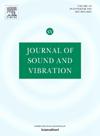Energy harvesting and passive mitigation from flutter via rotary nonlinear energy sink
IF 4.3
2区 工程技术
Q1 ACOUSTICS
引用次数: 0
Abstract
Nonlinear Energy Sinks (NES) are passive vibration absorbers that transfer energy to a nonlinearly-attached secondary mass for passive dissipation at broad excitation ranges. Aeroelastic flutter is a potential application of NES passive control once it presents complex, self-excited, and self-sustained potentially harmful high-amplitude oscillations. When combined with a transducer mechanism, NES devices can perform simultaneous passive control and electricity generation, reusing otherwise dissipated structural energy. This work proposes an apparatus comprising a rotary Nonlinear Energy Sink coupled with an energy harvester (RNES-EH) to an aeroelastic typical section. A two-dof airfoil subjected to an unsteady aerodynamic load model is considered. A pitching hardening nonlinearity is adopted, inducing limit cycle oscillations in the post-critical response. The RNES-EH is introduced at the airfoil chord, and the aeroelastic electromechanical equations of motion are derived. Numeric characterization is performed on the basis of the behavior of the bifurcation and suppression regimes of the system for a reference device. A performance index is introduced to balance energy harvesting and vibration reduction. Parametric bifurcation analysis is carried out to determine the influence of parameter design on vibration mitigation and electricity generation. The device is reported to generate electric power without disrupting the suppression performance. Mechanically, a low-radius and high-mass device close to the leading edge and with some damping is required for optimal suppression, although performance is limited due to subcritical behavior. Optimal load resistance is determined for maximum electricity extraction. The results show that the concept is promising and viable for many aeroelastic and fluid–structure interaction problems.
求助全文
约1分钟内获得全文
求助全文
来源期刊

Journal of Sound and Vibration
工程技术-工程:机械
CiteScore
9.10
自引率
10.60%
发文量
551
审稿时长
69 days
期刊介绍:
The Journal of Sound and Vibration (JSV) is an independent journal devoted to the prompt publication of original papers, both theoretical and experimental, that provide new information on any aspect of sound or vibration. There is an emphasis on fundamental work that has potential for practical application.
JSV was founded and operates on the premise that the subject of sound and vibration requires a journal that publishes papers of a high technical standard across the various subdisciplines, thus facilitating awareness of techniques and discoveries in one area that may be applicable in others.
 求助内容:
求助内容: 应助结果提醒方式:
应助结果提醒方式:


